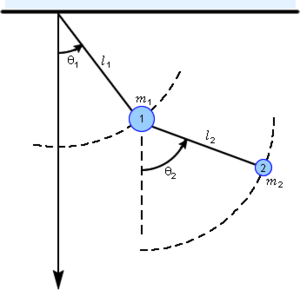Coupled Oscillator: Double Pendulum: Difference between revisions
Jump to navigation
Jump to search
No edit summary |
No edit summary |
||
| Line 18: | Line 18: | ||
The system of differential equations describing the motion is nonlinear |
The system of differential equations describing the motion is nonlinear |
||
: <math>(m_1+m_2)l_1^2\theta_1^{\prime\prime} + m_2l_1l_2\theta_2^{\prime\prime}cos(\theta_1-\theta_2) + m_2l_1l_2(\theta_2^{\prime})^2sin(\theta_1-\theta_2)</math> |
: <math>(m_1+m_2)l_1^2\theta_1^{\prime\prime} + m_2l_1l_2\theta_2^{\prime\prime}cos(\theta_1-\theta_2) + m_2l_1l_2(\theta_2^{\prime})^2sin(\theta_1-\theta_2) + (m_1+m_2)l_1gsin\theta_1 = 0</math> |
||
: <math>m_2l_1^2\theta_2^{\prime\prime} + m_2l_1l_2\theta_1^{\prime\prime}cos(\theta_1-\theta_2) - m_2l_1l_2(\theta_1^{\prime})^2sin(\theta_1-\theta_2) + m_2l_2gsin\theta_2 = 0</math> |
|||
Derive the system of differential equations describing the straight-line vertical motion of the coupled spring shown in Figure 1. Use Laplace transform to solve the system when <math>k_1=k_2=k_3=1 \frac{}{}</math>, <math>m_1=m_2=1 \frac{}{}</math>, and <math>x_1(0)=0 \frac{}{}</math>, <math>x'1(0)=-1 \frac{}{}</math>, <math>x_2(0)=0 \frac{}{}</math>, and <math>x'_2(0)=1 \frac{}{}</math>. |
Derive the system of differential equations describing the straight-line vertical motion of the coupled spring shown in Figure 1. Use Laplace transform to solve the system when <math>k_1=k_2=k_3=1 \frac{}{}</math>, <math>m_1=m_2=1 \frac{}{}</math>, and <math>x_1(0)=0 \frac{}{}</math>, <math>x'1(0)=-1 \frac{}{}</math>, <math>x_2(0)=0 \frac{}{}</math>, and <math>x'_2(0)=1 \frac{}{}</math>. |
||
Revision as of 21:23, 6 December 2009
By Jimmy Apablaza By Jimmy Apablaza
This problem is described in Page 321-322, Section 7.6 of the A first Course in Differential Equations textbook, 8ED (ISBN 0-534-41878-3).
Problem Statement
Consider the double-pendulum system consisting of a pendulum attached to another pendulum shown in Figure 1.
Assumptions:
- the system oscillates vertically under the influence of gravity.
- the mass of both rod are neligible
- no dumpung forces act on the system
- positive direction to the right.
The system of differential equations describing the motion is nonlinear
Derive the system of differential equations describing the straight-line vertical motion of the coupled spring shown in Figure 1. Use Laplace transform to solve the system when , , and , , , and .








